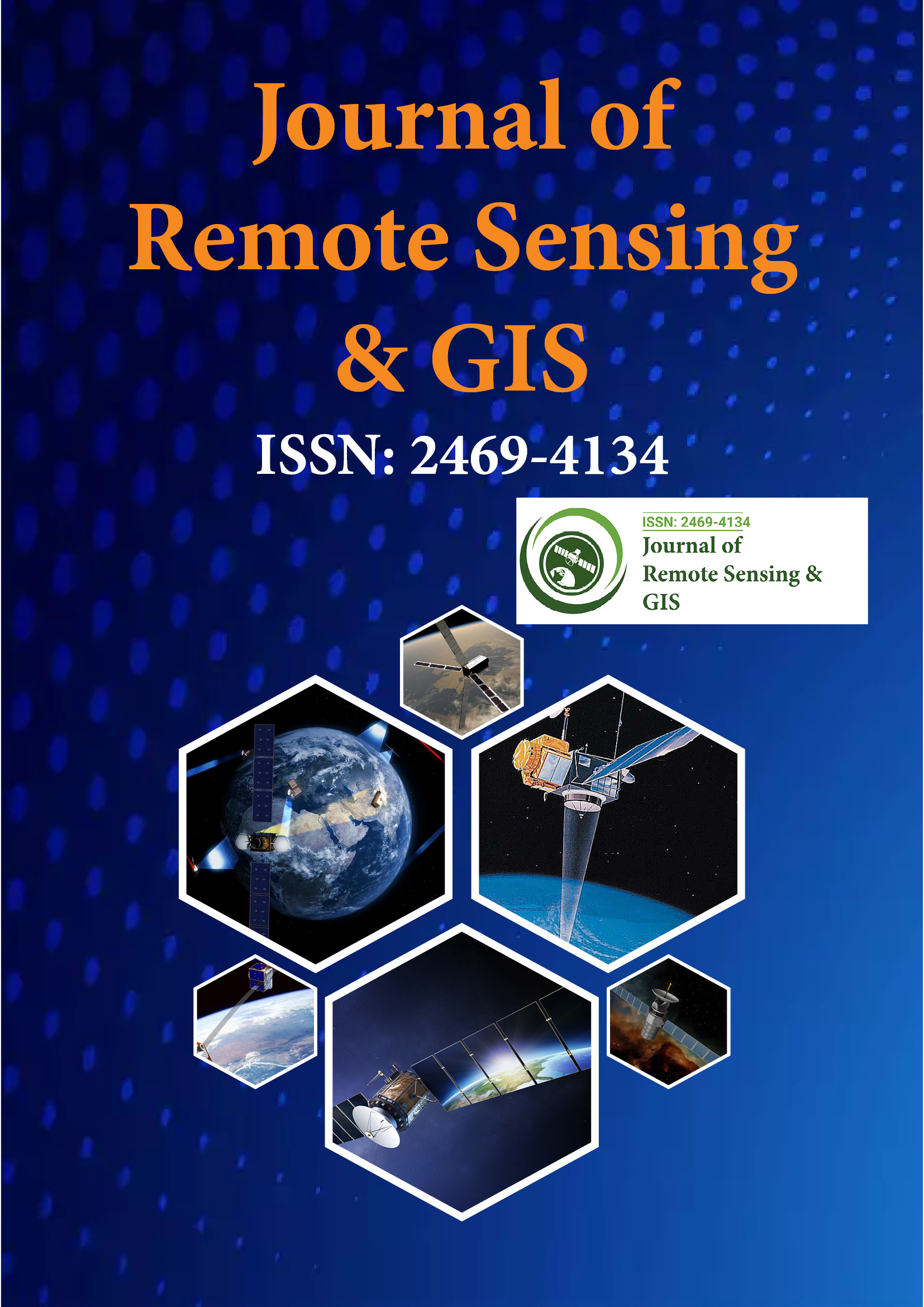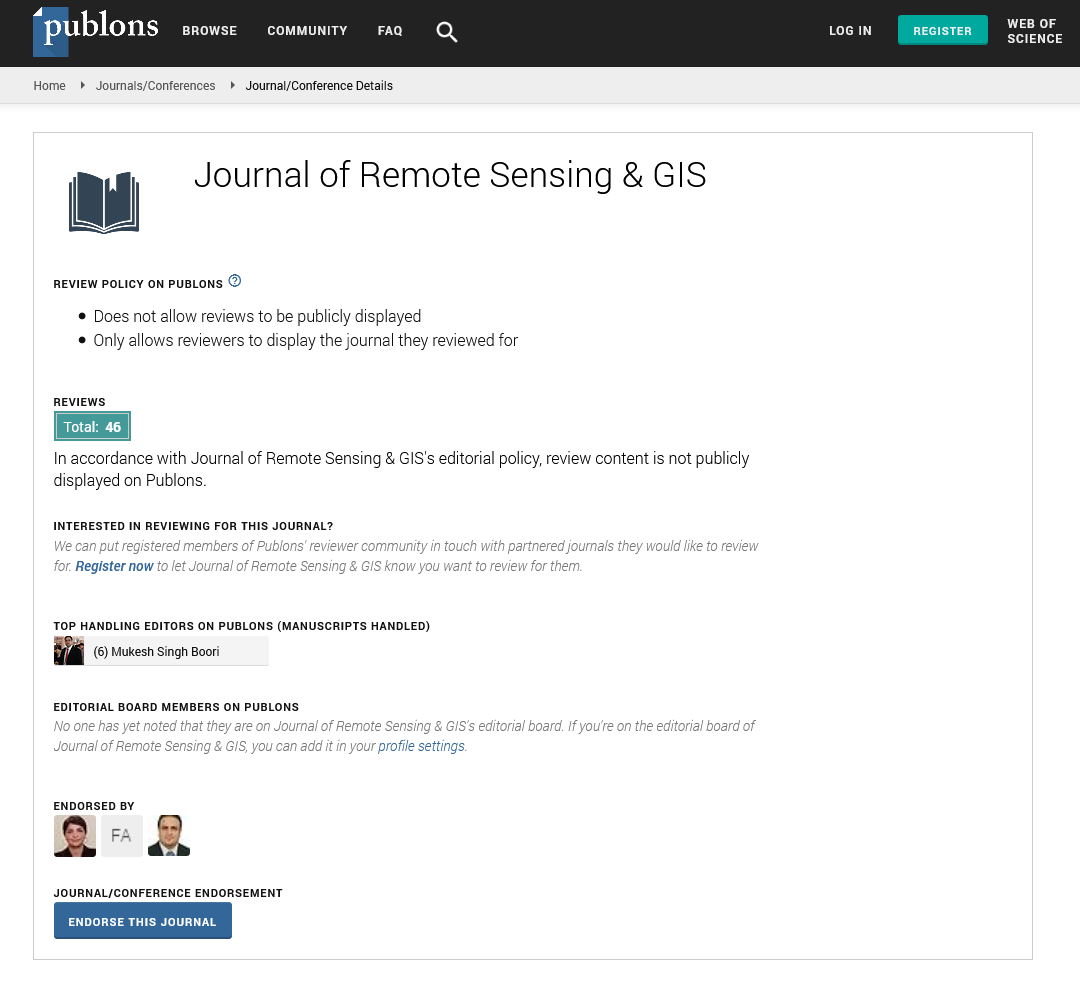Indexed In
- Open J Gate
- RefSeek
- Hamdard University
- EBSCO A-Z
- OCLC- WorldCat
- Publons
- International Scientific Indexing
- Euro Pub
- Google Scholar
Useful Links
Share This Page
Journal Flyer

Open Access Journals
- Agri and Aquaculture
- Biochemistry
- Bioinformatics & Systems Biology
- Business & Management
- Chemistry
- Clinical Sciences
- Engineering
- Food & Nutrition
- General Science
- Genetics & Molecular Biology
- Immunology & Microbiology
- Medical Sciences
- Neuroscience & Psychology
- Nursing & Health Care
- Pharmaceutical Sciences
Perspective - (2025) Volume 14, Issue 1
Satellite-Based Change Detection: Methods for Tracking Environmental and Land Use Transformations
Leonel Johns*Received: 25-Feb-2025, Manuscript No. JGRS-25-28687; Editor assigned: 27-Feb-2025, Pre QC No. JGRS-25-28687 (PQ); Reviewed: 14-Mar-2025, QC No. JGRS-25-28687; Revised: 21-Mar-2025, Manuscript No. JGRS-25-28687 (R); Published: 28-Mar-2025, DOI: 10.35248/2469-4134.25.14.373
Description
Change detection refers to the process of identifying differences in the state of an object or phenomenon by observing it at different times. In remote sensing, this involves analyzing satellite or aerial imagery acquired at multiple time intervals to detect and quantify changes on the earth's surface. These changes may result from natural processes such as erosion, flooding, or vegetation cycles, or from human activities like urban expansion, deforestation and agricultural conversion.
With increasing availability of high-resolution and temporally frequent remote sensing data, change detection has become an essential component of environmental monitoring, land use planning, disaster management and resource assessment.
Principles of change detection
Change detection involves a comparison of images captured at different dates over the same geographical area. The process typically includes the following steps:
Data acquisition: Images must be selected from consistent sensors or platforms to minimize discrepancies caused by sensor characteristics. Multispectral, hyperspectral, or radar data are commonly used.
Preprocessing: Preprocessing is necessary to correct for atmospheric effects, sensor noise and geometric distortions. Radiometric and geometric corrections ensure that images are spatially and spectrally aligned.
Image registration: Accurate alignment of multi-temporal images is fundamental for meaningful change detection. Image registration involves matching image features or using ground control points to overlay images precisely.
Classification or transformation: Images may be classified into thematic classes (e.g., water, vegetation, built-up) using supervised or unsupervised classification techniques.
Alternatively, mathematical transformations or change indices may be applied.
Change analysis: Once data are prepared and classified, changes between time steps are assessed using comparison techniques. The output may include change maps, matrices, or statistical summaries.
Techniques for change detection
A variety of methods are used in remote sensing to identify and quantify changes:
Image differencing: This technique subtracts pixel values from two images acquired at different times. Significant differences indicate potential change. This method is simple and computationally efficient, though sensitive to noise.
Change Vector Analysis (CVA): CVA calculates the magnitude and direction of change in multi-dimensional spectral space. It is useful for detecting changes in multi-band datasets, such as multispectral imagery.
Post-classification comparison: Classified maps from two different dates are compared pixel by pixel. This approach is often accurate but depends heavily on the quality of the classification.
Principal Component Analysis (PCA): PCA reduces data dimensionality and highlights areas of change by transforming original image bands into uncorrelated components. It can be applied to image pairs to isolate change information.
Normalized difference indices: Spectral indices such as the Normalized Difference Vegetation Index (NDVI), Normalized Difference Water Index (NDWI), or Built-up Index can be calculated for both time periods. Differences in these indices help detect thematic changes.
Machine learning approaches: Recently, techniques such as Support Vector Machines, Random Forests and Neural Networks have been applied to automate change detection, especially in large datasets or complex landscapes.
Applications of change detection
Change detection techniques are widely applied across multiple fields:
Land use and land cover monitoring: One of the most common applications involves tracking urban sprawl, deforestation, agricultural expansion and wetland changes. Long-term land cover maps help planners assess environmental trends.
Disaster assessment: Satellite data captured before and after events such as floods, wildfires, earthquakes, or hurricanes can be compared to evaluate damage and guide emergency response.
Environmental monitoring: Remote sensing supports monitoring of desertification, coastal erosion, glacier retreat and water body fluctuations. These observations inform climate research and ecosystem management.
Infrastructure development: Construction of roads, dams and settlements can be monitored using change detection techniques. This is particularly useful in remote areas where ground surveys are limited.
Agricultural assessment: Seasonal and annual changes in croplands can be tracked to estimate yields, monitor crop health and detect land abandonment or rotation practices.
Challenges in change detection
Despite its utility, change detection is not without difficulties:
Sensor differences: Differences in sensor resolution, spectral bands and viewing angles can introduce inconsistencies in multitemporal analysis.
Atmospheric and illumination variability: Changes in sunlight, shadows and atmospheric conditions can mimic or mask actual surface changes.
Temporal misalignment: Images acquired in different seasons or phenological stages can reflect natural variation rather than actual change, complicating interpretation.
Classification errors: Misclassification in either of the time-step images can propagate through the comparison process, leading to inaccurate change maps.
Mixed pixels: At coarse spatial resolutions, a single pixel may contain multiple land cover types, making it difficult to detect small or subtle changes.
Future perspectives
Advancements in remote sensing technologies continue to improve change detection capabilities. Higher temporal resolution from platforms like Sentinel-2 and PlanetScope allows for near real-time monitoring. Cloud-based platforms such as Google Earth Engine have also made processing of largescale, multi-temporal datasets more accessible.
The integration of optical and radar data can overcome cloud cover issues and enhance detection in challenging environments. Moreover, the use of deep learning and artificial intelligence holds potential to increase automation, accuracy and scalability of change detection analyses.
Conclusion
Change detection through remote sensing provides an effective approach for monitoring dynamic landscapes. By analyzing multi-temporal imagery, it supports decision-making across environmental, agricultural and urban domains. Although challenges remain, ongoing technological progress continues to enhance the precision and efficiency of change detection methods.
Citation: Johns L (2025) Satellite-Based Change Detection: Methods for Tracking Environmental and Land Use Transformations. J Remote Sens GIS.14:373.
Copyright: © 2025 Johns L. This is an open-access article distributed under the terms of the Creative Commons Attribution License, which permits unrestricted use, distribution and reproduction in any medium, provided the original author and source are credited.

